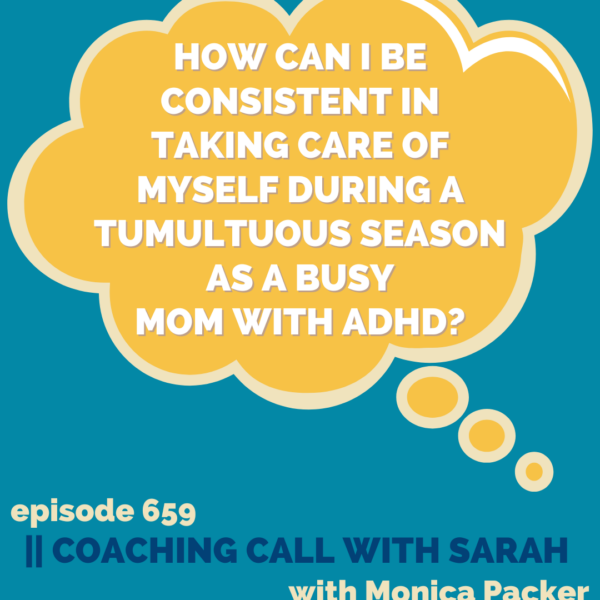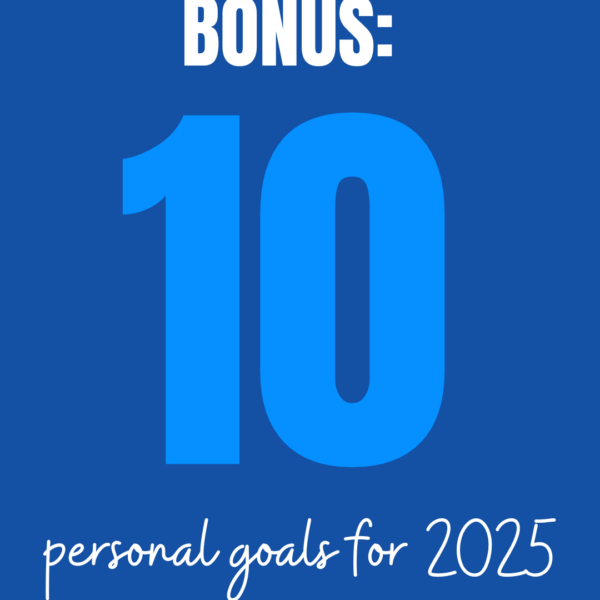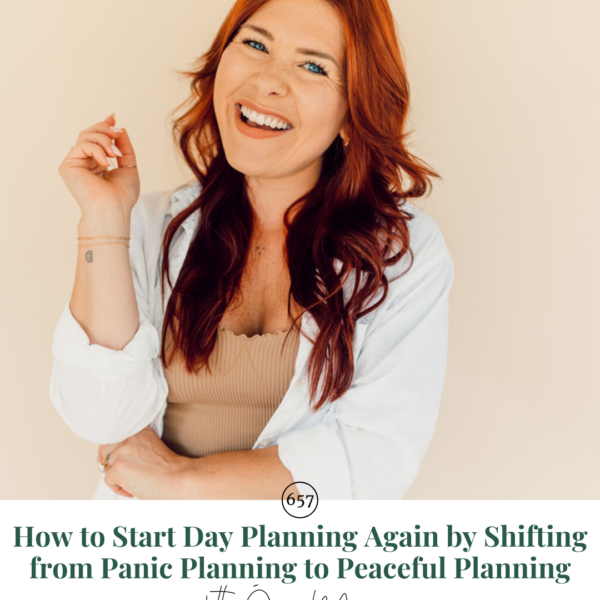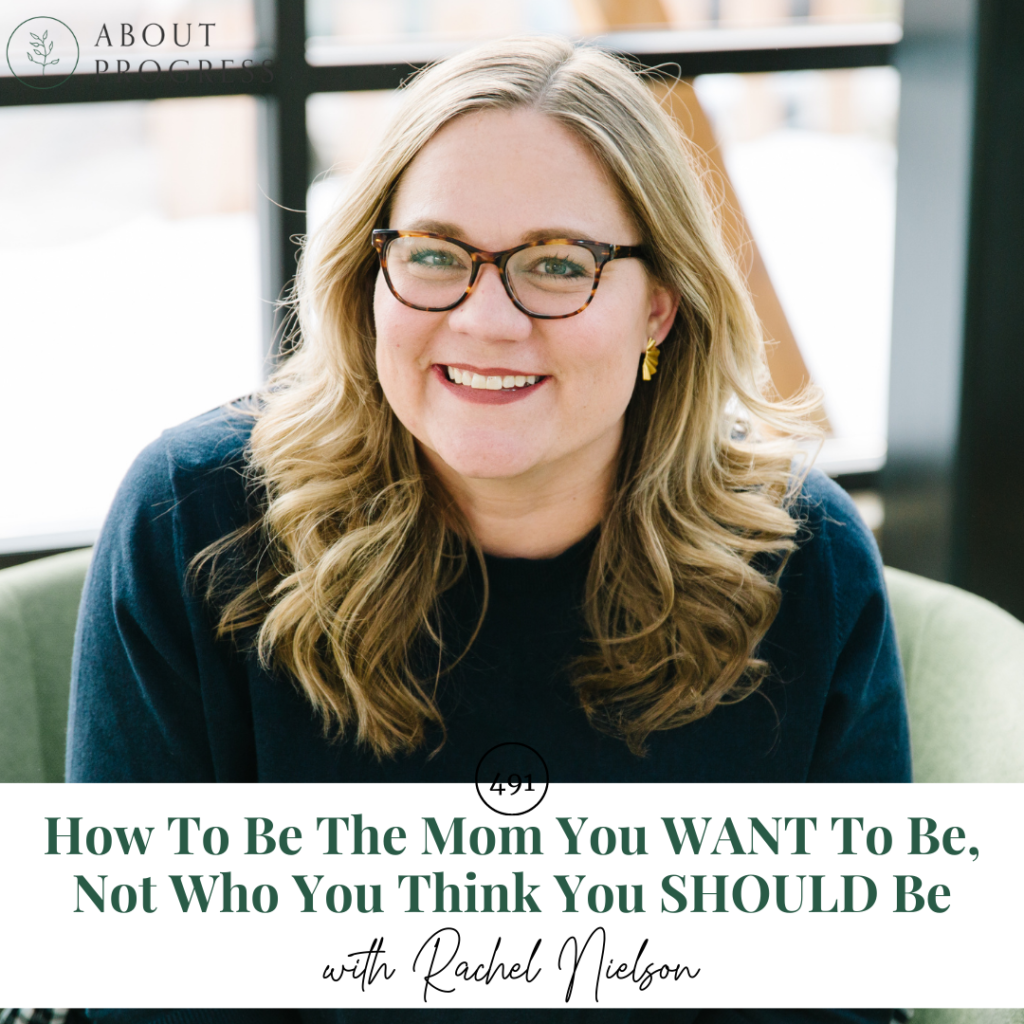
Have you ever wished that you could love motherhood, as much as you love your kids? That’s a little line I borrowed from my dear friend, Rachel Nielson of the 3 In 30 Takeaways for Moms podcast, who is an expert on that exact subject. Motherhood is full of wonderful surprises, but also hard surprises, and it does not come instinctually to everyone, as you’ll hear was the case with me and Rachel.
If you struggle with what you think motherhood SHOULD look like, and would rather uncover what you want your motherhood to look like, Rachel has several actionable steps you can take. She uses the analogy of cleaning out a closet to explain the steps to declutter your motherhood, and it really makes sense. While this may be a long process, it is possible to feel some change right away, as you find joy and alignment in your role as the mother you want to be.
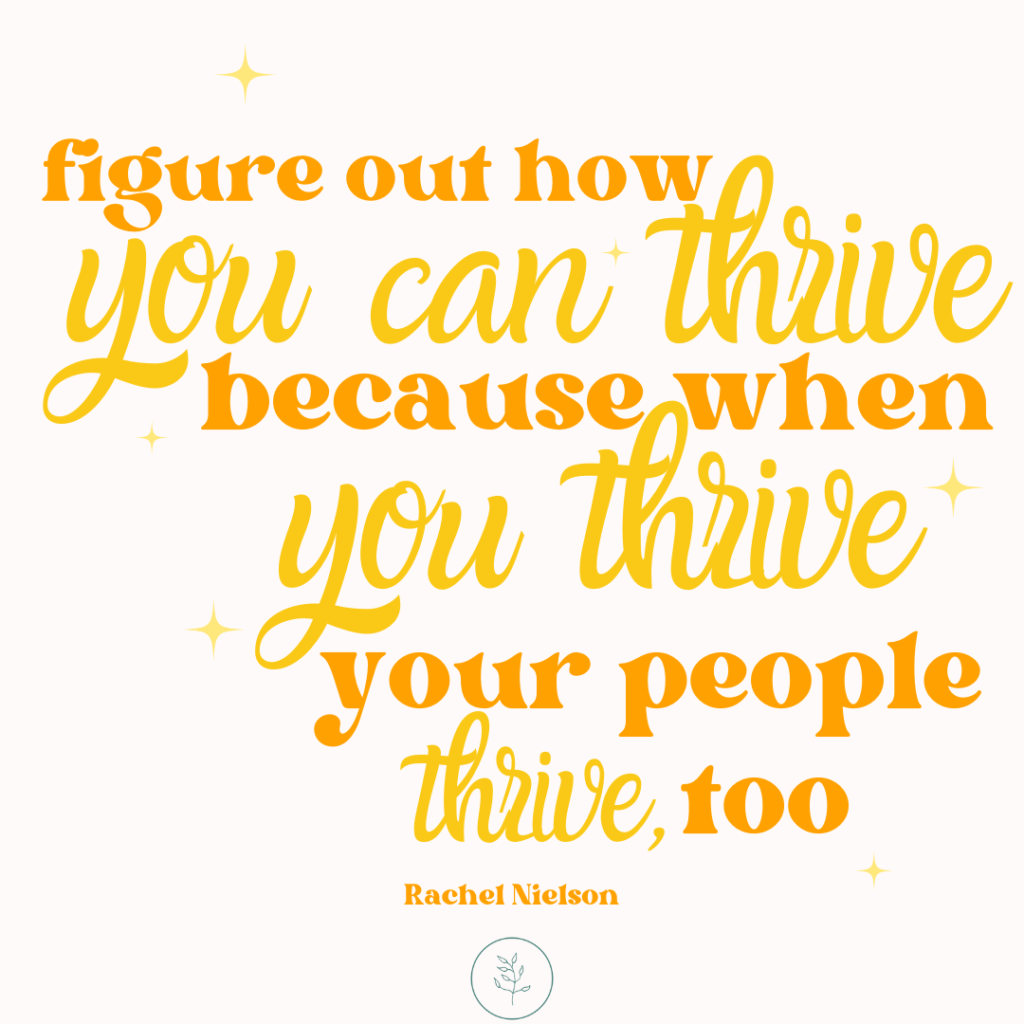

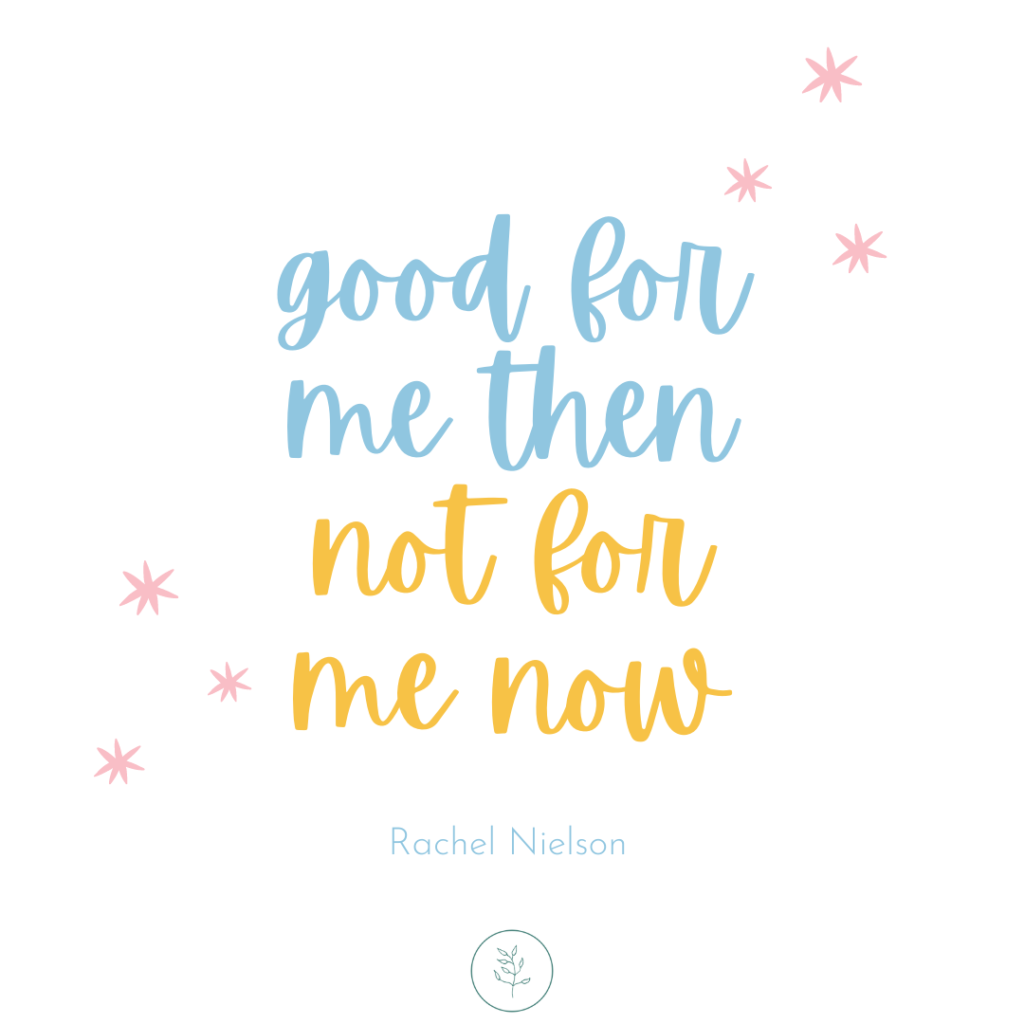
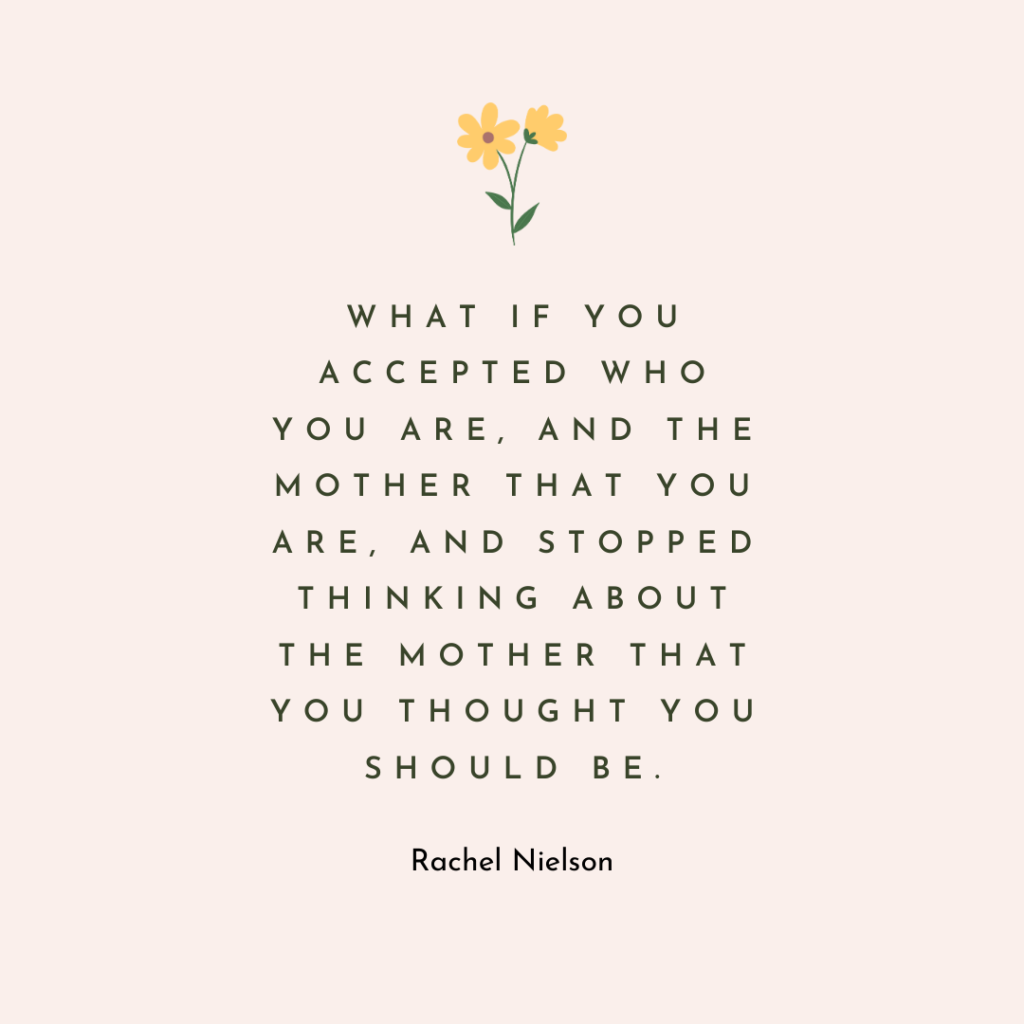
About a few other things…
Do you struggle to create habits that stick? It’s not your fault. The truth is simple: you’ve been trying to form habits using methods designed for perfect robots–not real women living real lives. It’s time to change that. If I could help you gain confidence in creating habits AND guide you to uncover the ONE supportive habit to deeply care for yourself, could you commit 21 days to learning this method? The Sticky Habit Method is a 21-day course that revolutionizes the habit-formation process. It’s real habits for real women.
Sign up for the Go Getter Newsletter to get Progress Pointers in your inbox every Tuesday.
Use code PROGRESS for 20% off a 90-day supply of Just Thrive Probiotic and Just Calm at https://justthrivehealth.com/discount/PROGRESS
You can listen the episode below, or on Apple Podcasts/iTunes, Spotify, Youtube, Overcast, Stitcher, Pocketcasts, or search for “About Progress” wherever you get your podcasts. If you like the show please share it, subscribe, and leave a review!!
SHOW NOTES
Rachel’s website, Instagram and course (10% off with code ‘aboutprogress’)
Finding Me Academy
DSL Guide
Try me FREE Class and check out my NEW Habit Course
Leave a rating and review for the podcast!
Lend your voice and experience + be featured on the show HERE
Join Monica on Facebook and Instagram
Songs Credit: Pleasant Pictures Music Club
TRANSCRIPT
Monica: Welcome back to About Progress, Rachel Nielsen.
Rachel: Oh, thank you so much for having me. You, you’re just my favorite and I love that I’m back on the show.
Monica: Oh, that makes me really happy to hear that. We definitely have a history that I’ll make sure I share in the introduction to this episode, but I’m, I’m so happy you are here because what we get to share today, Is one of those moments I had with you as a friend, but also someone who learns from you.
We had this workshop that we did a couple years ago called Rediscover You and you were one of the three speakers we had at that workshop. And I sat there, and we’re both former teachers, but I sat there not only in awe of how you teach cuz you’re such an incredible teacher, but how applicable and practical, but also life changing.
It is what you taught that day and that’s what we’re really gonna be digging into today is those who are feeling like they’re struggling massively with motherhood and they don’t really know where to go from here. I wanna start by hearing your own story there, because that’s what I think helps the most when women know like, oh, it’s not just an expert who always knew better than me. Mm-hmm. And has always done better than me preaching at me. They get to learn from someone who gets it. Let’s start with your story then. You know, when did you struggle with motherhood and what was that like for you?
Rachel: I would say I struggled mightily with motherhood from the very beginning and it surprised me because I have always loved kids. I did a lot of work prior to becoming a mother with kids and teens and young adults just with youth. I was a teacher. I was a summer camp counselor for years. I really thought this is gonna come so naturally to me.
And I was raised in a religious culture where motherhood was really idealized and sort of taught that this is your divine calling. Mm-hmm. And women are made to nurture. And I, I thought that meant like, oh, it will just come really naturally to me, you know? And. So we went through years of infertility to get our kids, and I was just so ready to step into that role and was shocked by how difficult it was for me and how unfulfilling it felt to me to be not, I wouldn’t say motherhood was unfulfilling to me, but stay at home motherhood was unfulfilling for me, and I felt a lot of shame and guilt around that because I thought I should be able to figure out how to love this more. Like if I just work harder at it, if I. You know, read all the books, or if I going back to my religious roots, like if I just pray harder mm-hmm. Like God will help me to make this you know, to make me the perfect divine woman that I’m supposed to be, so that I can be a better stay-at-home mom to my children. But it was just really wildly outside of my skillset. Like I just, I didn’t, I hadn’t, I. I didn’t have the natural skills to take care of infants and a home and all of these things I had a lot of learning to do, which I think all new moms do, but maybe even more so for me.
Mm-hmm. And I just heaped a lot of guilt on myself for the fact that I wasn’t loving it more.
Monica: That’s where we kind of have this double-edged sword, right? Like, not only is it really difficult, but you make it more difficult by shaming yourself over it. Yes. And and really that’s not the, the guilt, right?
It’s the shame part that come from the shoulds. Mm-hmm. So when you, how did you recognize that gap, you know, af that gap between who you wanted to be, who you thought you were supposed to be as a mom, and how you were being as a mom. How did you recognize that gap? And then how did you switch from shaming and blaming yourself to realizing, oh, maybe it’s just because motherhood needs to look different.
Yeah,
Rachel: I mean, the gap was very apparent, so it’s, it didn’t, it wasn’t hard to recognize that I’m not thriving in this role. I’m not happy. I recently was looking back through old journals that I had kept at that time and. I read a conversation that I had had with my husband that I had written down in my journal, and it was like, yeah, kind of painful for me to read it.
Now looking back my husband had said something like, it’s really not fun to have a wife who hates her children. And I said, I don’t hate my children. And he’s like, no, you don’t hate your children, but you do hate motherhood.
And I said, I don’t hate motherhood. And he’s like, you hate stay-at-home motherhood. So this con like through that conversation we were able to get like down to what the actual problem was, but that’s like painful for me to read now because I desperately loved my kids all along. And, but the way that it was coming out was that I felt like I wasn’t connecting to them.
I wasn’t good at this. Like, the reason why my husband said that is because I would text him like all day long, I’m so miserable. Like, can you come home? I need help. I don’t wanna do this anymore. So of course this was like miserable for him too. Yeah. And so like, It was very apparent that I wasn’t thriving, I wasn’t doing well, I wasn’t meeting my own expectations, and my misery was like run, running off onto everybody else in mm-hmm.
In my family. And instead of, instead of seeing that as like, I need support, I was, I saw it as, I need to change myself. Like I need to be better. And so that’s when I tried so hard to, well, it actually led me to like eating disorder behaviors, which, you know, Monica, that I was binge eating to try to comfort these feelings I was having.
And lots of really negative, negative self-talk. And finally, after months of this, probably even a year of this, I realized like, whoa, I need some help. Yeah. And I went to therapy and it was in therapy that I started to learn new tools for like, this isn’t about you being a terrible person. This is about you trying to fit yourself into a box that doesn’t fit you.
And what if you just accepted yourself? Like what would, what if you accepted who you are and the mother that you are, and stopped thinking about the mother that you thought you should be. Mm-hmm. And like I learned a lot of like cognitive behavioral techniques to like reframe my thoughts and to recognize a really negative thought when it happened and to sort of call it out and reframe it.
And, It was a process of a lot of years to realize that the shoulds that I was putting on myself, telling myself I should be this way to be a good mom, were just false. Mm-hmm. And that I could be the good mom that I already was. I could be myself. Mm-hmm. And that everyone in my family would be blessed for it.
I’m thinking
Monica: about the women who are listening and they’re feeling that gap in their lives. The gap of the mother that there are, they are right now, and the mom that they wanted to be or thought they were going to be. Mm-hmm. Or thought they think they should be, and how? Like you said, the initial frame of working on it is, I just gotta work on myself when really the answer for you is I actually need more support.
Yeah. And this is why I’d like to have kind of a tricky conversation. Mm-hmm. Because you have an incredible podcast that I think all parents benefit from. It’s more geared towards moms, but I send it to my husband like every week, like, listen to this. So we can be on the same page every week. And it’s full of incredible advice.
And you do have really practical episodes of tips and advice on how to help your kids during certain stages, but what I love about your podcast so much is how it teaches women more about the support part that I think is often missing. So let’s talk about that. Why? Why does parenting advice often get it, not get it wrong?
Because I’m sure there’s, the advice itself is good, but how does it often fail moms?
Rachel: Hmm. Well, parenting advice, it’s, it’s all written from somebody who doesn’t know you and doesn’t know your children, and so you can, you can read it and take it with a grain of salt and believe I do plenty of that.
Obviously, I run a podcast all around takeaways for motherhood. But also, like you said, I, I hope that the deeper message that women get when they listen to my show is, You know what’s best for your kids, you know what’s best for yourself, and here are some tools and takeaways to consider. But at the, at the base of it you have to have a strong sense of self.
And when I was a new mom, I didn’t have that. Mm-hmm. And so all of the advice and the parenting books and everything, Made me feel more guilty and more shoulds were added onto my life and also onto my children. I would read these books or watch the Instagram reels and say, if I do this technique, they should respond this way.
Like, why is my kid different? Why is my kid broken? You know, why am I broken Versus mm-hmm. Taking that advice with a grain of salt and saying like, my kid is not a textbook and I am a unique mom. And I need to not just look at like surface level tactics, but also like what’s going on deeper in me? What supports do I need?
Mm-hmm. How can I get to know myself better in a way that will radiate out to the tactics and the behaviors that I can implement in my home and in my family?
Monica: It’s so fascinating because. We’ve both lived this out, but in, you know, different ways because again, we are unique moms and our kids are unique too.
But just that shift in recognizing it needs to be more about myself. Mm-hmm. And how that’s not selfish. That actually helps my kids. Yes. That changed my mothering 100%, like an A 180 flip. And I could use the same techniques as before, but they would actually work because mm-hmm. I came to it as a whole person.
As myself. Yes. Not as someone else. Or I could try on a different tactic and follow some good parenting advice, but still it was different. Yeah. Why do you think that is?
Rachel: Yeah, I mean, I. It’s just a more centered approach. It’s a, you know, I am fascinated by the word selfish and thinking about what does that actually mean?
And one of my favorite therapists who you were the first person that introduced me to her work, Dr. Jennifer Finlayson Fife I heard, I’ve heard her say that we use the word selfless as if it’s a good thing. But when you actually break that word down, selfless, it means without a self. And do we really want to be making choices from a place where we don’t have a sense of self?
No. We want to be making choices that the world might see as quote, selfless, but we’re making them from a very centered, we’re making them as an act of self. Mm-hmm. Is what Jennifer would say. We’re not a victim. We’re choosing. Yes, the things that we do for other people, because we deeply know ourselves.
And so I’ve heard you talk about being full of yourself in a good way. You know, most of the time we hear people use that in a bad way. But being filled up and full of who you are, knowing who you are and bringing that to your life. As well as I’ve heard Brook Snow talk about the term self-centered in a good way.
Centered in yourself. Yeah. So I just love kind of playing with these words and thinking about what does this actually mean and how am I trying to be selfless in my motherhood in ways that aren’t actually an act of self? So then I’m resentful and I’m a victim versus. Being selfless in ways that really come from deeper, the best parts of me.
Mm-hmm. And once I have that anchor, then you know, I try the parenting strategy or tip with my kids and it doesn’t work. And I can kind of laugh about it and be like, well, it didn’t work, gonna try something else. Whereas if I try that strategy from. A broken place where I’m not feeling really sure in myself, then it doesn’t work and I spiral and I’m the worst.
They’re the worst. This is never gonna get easier. Like it’s just a completely this, the outcome is the same, but all of the thoughts around it are totally different when you’re steady and stable in yourself, in your sense of self versus not. And as I’ve thought about this, I’ve thought about an image that’s helped me of like a big tent and how.
You know, I’m thinking like a big, like a reception, a party tent. Yeah. Like where you would host an event with like maybe hundreds of people and you have to get that center pole holding the tent up like that has to be down deep and secure. It’s the anchor. And once you have that, then you can expand out this tent that can give like refuge to hundreds of people and a really wonderful time and they can like enjoy the warmth underneath this tent.
Whereas if that center pole is not securely anchored and deep, then it’s just the whole tent’s gonna fall over. It’s not gonna be safe for people to be in there. And we as mom are, are the, that center pole for our kids of the tent that like when we are deeply, firmly grounded and know who we are and are taking care of ourselves, it actually makes it more possible for for our children and for others that we love to like enjoy the warmth that’s available underneath, like kind of our shelter versus if we are like shaky and unstable and we don’t know ourselves and we’re trying to take care of everybody else, but we really can’t because we aren’t deeply anchored.
Monica: Makes complete sense. And as a visual learner, that’s something that is gonna sink into my mind. Whenever I have that little feeling crop up, like, oh, I’m being selfish, or that guilt or that shame come up, I can visualize that. Like I need to be that strong centered pull. Mm-hmm. And that way I have more to give.
Monica: You have a good term for this too. A self-assured motherhood. That’s what I love about the, you know, what you teach is, let’s give moms great advice, but let’s make sure they are starting from that place of centering that they feel self-assured as a mom.
So, mm-hmm. Let’s talk to the woman who want that now. They want to go from struggling to supported. Hmm. And they, and in the process of being more supported, They better support everyone and everything else that they’re connected to, that they’re that, that they’re in charge of. Mm-hmm. So what can they do if these women want to go from struggling to supported?
Rachel: Yeah. So in my course, declutter Your Motherhood, I walk women through three steps to decluttering a closet and how that can apply to decluttering the shoulds in your own life. And so I’m going to, Walk you through those three steps just briefly. If you want a deeper dive, then you can look into my course, but I wanna give you the three steps and these aren’t like quick hacks.
You know, I wish that it were as easy as me just saying like, oh, if you’re struggling with your motherhood, Start going on a fun family outing on Saturdays and everything will change. Yeah. And it’s like maybe, but more likely the stuff underneath the deeper stuff needs to change first. And just going on a fun family outing isn’t gonna fix it until you’ve looked more deeply at your shoulds and where they come from and you’re supporting and taking care of yourself.
So these three steps that I’m gonna give you, They may seem a little deeper and not as like actionable checklisty, but that’s because this is the…this is the work we have to do. Yep. To get to a place where we’re feeling better in our motherhood. So the three steps are inventory, edit, and make room, and I talk about how that is, you know what you would do in a physical space, like a closet if you were trying to declutter it, you would inventory everything that you have and then you would go edit.
You’d go through and decide what stays and what goes, and then you would have room in your closet after you’ve gotten rid of all the things you don’t want in there anymore to really add, you know, whatever it is that. That your wardrobe needs to bring a little like life and color and fun to your wardrobe, but you can’t really do that until after you’ve done the inventory and the edit.
And so for moms, I translate this to, if you’re trying to declutter your overwhelm or your negative feelings about motherhood or yourself first inventory, you’re overwhelm, edit your expectations and make room for joy. Mm-hmm. And so, Step one, inventory, you’re overwhelm. I wish that it could be as easy as like pull everything out of your closet and just start going through it.
It’s a little more challenging with deeper internal stuff, but I recommend that moms just sit down with a sheet of paper and. Just start to inventory and ask yourself, what are the shoulds that I’m holding onto in my motherhood right now? What are all the different ways that I’m shoulding on myself? And what thoughts or beliefs about myself and my motherhood are causing me pain?
Hmm. And so you can just start to like, brainstorm and write all those down and make a big list. It’s like making the invisible visible. That question of like, what is, what beliefs are causing me pain? You don’t have to do anything about it right now. You don’t have to know how to fix it, but just first write it down and get an inventory of it.
And that’s the first step
Monica: And, and like you said, the most tricky because it’s so sunken deeply to our subconscious that it’s mm-hmm. That it’s hard to recognize, but it’s also kind of painful to dig up. Yes, yes. And I remember when I did this workshop, when you taught it that during that bigger workshop that we did that was the hardest part, but it was the most necessary because then I can move on to like the practical parts about then editing and making room for what was going to bring joy.
I’m curious like what. You’ve taught this workshop live many times. Mm-hmm. Have there ever been some responses to even that first part, the inventory that surprised you?
Rachel: Yeah, I mean there’s emotional responses for sure. I wouldn’t say they surprise me because yeah, this is hard work. But like some women cry.
I had one woman stand up and leave my workshop cuz she couldn’t do it. Oh yeah. And she told me later, she was a friend of mine, she said, I’m so sorry I couldn’t, I couldn’t look at it like, I’m just not ready yet. And I’m like, that’s okay. Like if you, and that’s when I’d say if the pain is that deep…therapy.
Like definitely therapy if you drag up some stuff, but I also think that. It’s like a real organization project or decluttering project. If you’ve ever done that in your home, there’s a point in every one of those projects where you think like, why did I drag all this stuff out? Like it’s so much, I should have just left it like it’s when you have like all the piles all over Strau and you’re like, this is so much worse.
And you have to push through that messy middle to get to the more decluttered space at the end. And that’s what this can feel like when for women who start to really look at their underlying beliefs and their pain and different things, like there can be a moment where you’re like, I. Why did I even go there?
Like it was fine how it was, but you’re going to have so much more joy and fulfillment once you kind of go through this process and go through that messy middle. So I would just encourage moms to not be afraid of the emotions that come up when you do this type of work.
Monica: With that inventory part. When I personally did it, I was surprised by what came up in terms of what I thought my responsibilities should be as a good mom. Mm-hmm. Meaning like we have certain amounts of homemade meals each week and certain types of homemade meals, or that I’m the one doing the laundry.
Like it was more like the the tangible parts of motherhood. Mm-hmm. Mm-hmm. But like you said, also the deeper parts like that, I should love being with my kids every moment of every day.
Mm-hmm. And you’re like,
oh boy, I, I do want that. I don’t feel that way, but I can now see like, that’s more of a should.
So I’ve gotta think about what to do with that. And that’s where editing comes in. Right. So with editing mm-hmm. Tell us what, what we do there.
Rachel: Yeah. So once you have these thoughts and beliefs out on paper, whether they’re like deeper internal stuff or more like the activities you’re expecting of yourself in motherhood, like you just mentioned I would just choose one cuz you can’t overhaul everything all at once.
So I would just choose one and kind of interrogate it. And I love that idea. Michael Hyatt talks about how important it is to interrogate your thoughts. Hmm. So you’re kind of. Asking. You’re looking at it objectively and saying, Do I actually believe this? Hmm. So like you maybe were surprised to find like, whoa, I expect myself to make a homemade dinner seven days a week.
I didn’t even know that I expected that of myself till I sat here and wrote this down. Do I actually believe that that’s what makes a good mom? Yeah. And like, Your more rational self is like, no, that’s not what makes a good mom. So you kind of can like have a conversation with yourself around that belief.
So asking yourself questions like, where did this belief come from? Is it my family of origin? Is it my religious culture? Is it my social media, my friends? Does this belief actually help me be a better mom or does it drag me down? Is it possible that something else could be true?
And you know that I could reframe this slightly and it could all, and it could be true for me. And it’s not like a quick process. Sometimes you have to work for a long time to restructure your beliefs, but the first step is even becoming conscious of them. Jennifer Finlayson Fife always says, you can’t fix what you can’t see.
Mm-hmm. And so once you’ve sort of gotten a hold on, like, oh, I have a lot of really strange beliefs about what a good mother is that my logical mind doesn’t actually agree with, but my heart is still saying or true, I’m gonna start working on that. Like, I’m gonna start thinking about it and giving it, you know, more reflection and interrogating it a little bit and see if I can slowly start to shift those beliefs and edit and let go of some of them that aren’t making me happy.
Monica: Because that’s really what the heart of editing is. It’s letting go. Yeah. You know, and there’s different, I mean, sometimes it’s just a seasonal thing too. Like this doesn’t work for this season of my mothering. Mm-hmm. So I’m gonna let that go. And sometimes that helps me let go of it easier, cuz I can say, can come back to that one like, or I can prioritize that later.
So we’ve got inventory, edit what’s make room.
Rachel: So Make Room is the fun part where you start to realize that once you get rid of the shoulds and the things that don’t fit you very well, that there’s room for you to add stuff that you do that does fit you, that you do love. And I feel like you don’t often hear professional organizers talk about like adding, you only hear about them saying, take, take it away, purge it, declutter it.
But when I did a full organization project of my home, which is really what sparked my interest in this topic. I, when we were done editing, I had like five shirts and one pair of pants left. Yeah. And it’s startling to see it. And you’re like, what am I gonna wear? And then you realize, oh, the, that’s actually all I was wearing anyway.
Mm-hmm. The, the, I was always reaching for those things. Anyway, the rest of the clutter was just making me feel like I had a more full wardrobe or whatever, but it helped me to see, Oh, I could get some new pants that I actually really love. Like there’s room here, there’s space. I’m not just gonna get what’s trendy or whatever.
I’m gonna get what actually fits me. And I love, and you can do the same thing with your motherhood after you’ve, maybe you decide. I’m not gonna make a hot dinner seven days a week anymore. That makes no sense. I don’t wanna spend my time doing that. Instead, I’m gonna make a homemade dinner three nights a week, and on the other nights, now I have room and I’m gonna spend more time like we’re gonna go for family walks or I’m gonna join a class.
And just for me, like a hobby, something that really lights me up or we’re not gonna fill it with anything and we’re just gonna have more rest in our life. And do something simpler for dinner, like takeout or something quick, and then enjoy that time as a family to just be. So, the making room for joy is the really fun step after you’ve done this deeper work of inventorying your overwhelm and editing your expectations.
Monica: When we did that workshop, I remember listening to a woman describe how she found so much, so much fulfillment in having an outside passion that she wanted to bring that in.
But the reason why I’m bringing this up is cuz she said another thing that really brought her joy as a mom was working with her kids on their hygiene. So she loved bath time, she loved clipping their little tiny nails and getting them dressed and the reason why that struck me so much is cuz I hate that part.
Mm-hmm.
Rachel: I’m like, really? Yeah. I, and this was, this was many years ago. So many, I don’t remember all of the specifics, but yeah, that’s an interesting one. I’m like, and I, I
Monica: like hate cutting. I don’t know how, what the math is, and I probably should know this, like 20 times five, like a hundred nails is what I’m trimming.
Mm-hmm. Like that, that part makes me just so sad. So why I bring that up is cause. It’s so individual. That’s where the self discernment comes in. It’s the, this is where the tent pole analogy is so fantastic because it will be so different for each of us and that’s where we get to say, good for them, not for me.
Mm-hmm. Or vice versa. Good for me now. Not for them, so maybe they’re judging me, but that’s okay.
Rachel: We can let go. Or good for me then not for me now. Yes. Like I think a lot of women have a hard time letting go of things that they did love in one season or that really fit them in one season, and then now they’re in a new season and it’s like, it’s okay to say, that was wonderful for me back then, and now I can morph it into a new reality, you know?
And yeah.
Monica: Well, I’m nodding my head cuz I’m realizing that is happening to me right now. Like seven years ago, what was gonna help me show up better as a mom was having more ambition outside of motherhood. Mm-hmm. And I’ve been kind of realizing last few weeks I’m kind of feeling differently now. Like I still wanna keep with my podcast, but that’s it.
Like I don’t really find myself wanting to do anything else. I just want to, I’m like reversing. But it’s not because that was wrong then. It’s not necessarily wrong for anyone now it’s just. It’s my season. I’m, I’m ready to do it differently.
Rachel: Yeah. I love that you brought that up, Monica, because we’ve talked a bit about stay-at-home motherhood today and how it wasn’t super fulfilling for me, but I want everyone to know, like, I’m not saying that’s true for all.
Stay-at-home mothers at all. Yes. There are many stay-at-home moms who are very fulfilled, who just rock that role, you know? And it’s been interesting for me to realize that there are women who have the shoulds that are the exact opposite way. So actually one of the women who works for me, she was grew up in a culture and was always taught like your value is in the work you do outside your home.
Like of course you will be working and you got this education, you have a master’s like. She had never really considered that she could be a stay-at-home mom because of all of the pressure and the stress. And then recently she realized that what she really wanted was to be a stay-at-home mom. Yeah. And so decluttering her motherhood looked like setting down all of the outside expectations of work and everything.
And it’s funny because she’s not gonna be able to work. She, she resigned essentially. Yeah. And we were laughing about how she’s like, I’m a testament to your teachings. You taught me how to declutter my motherhood and now I can’t work for you anymore because I wanna be a stay-at-home mom. And I’m like, darn it.
Cause she’s amazing. So yeah. But I totally respect her choice. Mm-hmm. And I love seeing that process of figuring out what works for you and what you want for your motherhood. And that’s gonna look completely different from another woman. But the message, the real message is you don’t have to fit yourself in any box To be a good mom.
You have to figure out how you can thrive. Because when you thrive, your people thrive too. Mm-hmm. And your family thrives around you. Versus that sad, sad journal entry of like the ways that from that my misery was running out on my family and my children and my husband. You know, I felt like I was being selfless, making that choice to stay home, give up my career and everything.
But really in some ways that was the, that was a choice that was negatively impacting my family. So was it selfless? You know, or, I don’t wanna say it was selfish because that’s too loaded, but I just had to look at myself and say, Maybe the more selfless choice is to get a, to gain a sense of self. Hmm.
And to accept myself so that I can be the loving, centered, grounded mom that I wanna be,
Monica: this has been really needed. I didn’t even know I needed this. I thought I had looked it out a few times, especially going through your workshop and now I’m just recognizing I think it’s time for me to do another inventory and then another edit, another make room.
Yeah. And this is where I kind of wanna bring, I wanna bring it back to your course because I imagine. This is something where like me, women will need, want to have something that they can revisit. Mm-hmm. And also have something that is not just like, let’s give you an overview. Let’s go really deep in these.
Mm-hmm. In, into these three, what, what did you call them? Not three
Rachel: categories. I just call ’em three steps. Yeah, yeah.
Monica: To go deeper into these three steps. So tell them about Declutter Your Motherhood and how it’s now being released as a course.
Rachel: Yeah, so you’re absolutely right, Monica. I don’t know anybody that just declutters their closet one time and never again for the rest of their life. It, this is an ongoing process, and so what I love about making this course available online for people is that you can. Once you purchase it, you can go back to it anytime you need.
So do it now and then in a year or three years. And it’s an audio course version, so it’s really intended for the busy mom who doesn’t wanna sit down and log in on a computer and watch videos. It’s all gonna be on a private podcast feed so you can just listen to it while you’re doing carpool. Commuting to work.
And it comes with a very detailed workbook. So you listen to the lessons and then when you have some more reflective time, you do the like journaling and figure out how it really applies to your life. But it’s 10 lessons all on a private podcast feed. Walking through these three major steps of decluttering your motherhood and guiding you through how to find and make room for more joy in your unique motherhood.
Monica: And this is where I’d like to really strongly advise women to do it because I, I can just even see that inventory step alone needing to have someone almost hold my hand. Mm-hmm. Not only with how you teach, but also with that workbook to be able to say, these are the types of questions that can help you even identify what’s so deep in your subconscious that you can’t just drum it up yourselves.
Yeah. So here you go. Let’s, let’s walk through that. And the making room part too is like a whole other layered thing where. Our the shoulds can creep back in, or our fears or our comparison to others where I, I know that you guide women really through that in ways that make it make sense so they’re not just coming up with it.
Rachel: The making room part is the most fun because that’s when women start to dream. Mm-hmm. And really, you know, I’ve included so many examples in the audio course because I’ve taught this workshop live about 12 times. So I went back and I watched old footage of old workshops and I pulled like examples from real women of what they do in each one of these steps.
So even though it’s not. A live workshop you’re still gonna be hearing from, I even include some audio clips. So you’re hearing from lots of other women who’ve done this work, and hopefully it can kind of spark your mind. What do I want? What do I dream about from my motherhood and my life? So I’m really excited to offer this in this format, and if your listeners are interested, they can go to 3in30 podcast.com/declutter and they can use the code aboutprogress for 10% off.
Awesome.
Monica: Great. Thank you. I’m excited.
Rachel: Yeah, I’m excited too.
Monica: Rachel, you are, So incredible. I respect you so much. I feel so lucky to be your friend. Oh, and to just learn from you. So thank you for all you do.
Rachel: But the feeling, the feeling is so mutual. And honestly, Monica, my workshop wouldn’t exist had you not invited me to teach at your workshop. When you invited me to teach at Rediscover you.
I didn’t quite know what I would teach about. You gave me like a general topic and then I happened to be doing that organization project. Yeah. And all of a sudden it just, Came to me how I wanted to structure this. So you, your invitation for me to speak, your belief in me that I would come up with something great to teach women is what sparked this, this tool that over 250 women have gone through this now, this course.
So thank you for your belief in me and for encouraging me to put my work out in the world.
Monica: Aw. That made me tear up. I’m, I’m glad to have a hand on that. I’ll take credit. I’ll take credit for a small piece of that. For those who want to follow you online, I know we’ll say, first go to your podcast three and 30 takeaways for mom’s podcast and on Instagram, what are you three and 30 podcasts, right?
Yep.
Rachel: Mm-hmm. Okay. Yep. Cool. And we ble it all. What were you gonna say? Okay, great. Just that, that three and 30 podcast.com/declutter is where they can find the course.
Monica: Great. Rachel, thank you again.
Rachel: Thank you so much for having me.
Monica: This is someone who has been there and understands and can now pass on, you know, this, these I am so falling over my words today.
I’m just gonna cut that all out.
Rachel: They get to learn. That was great.
Monica: Okay. Well, I, I’m still rusty. This is like my second interview back so,
